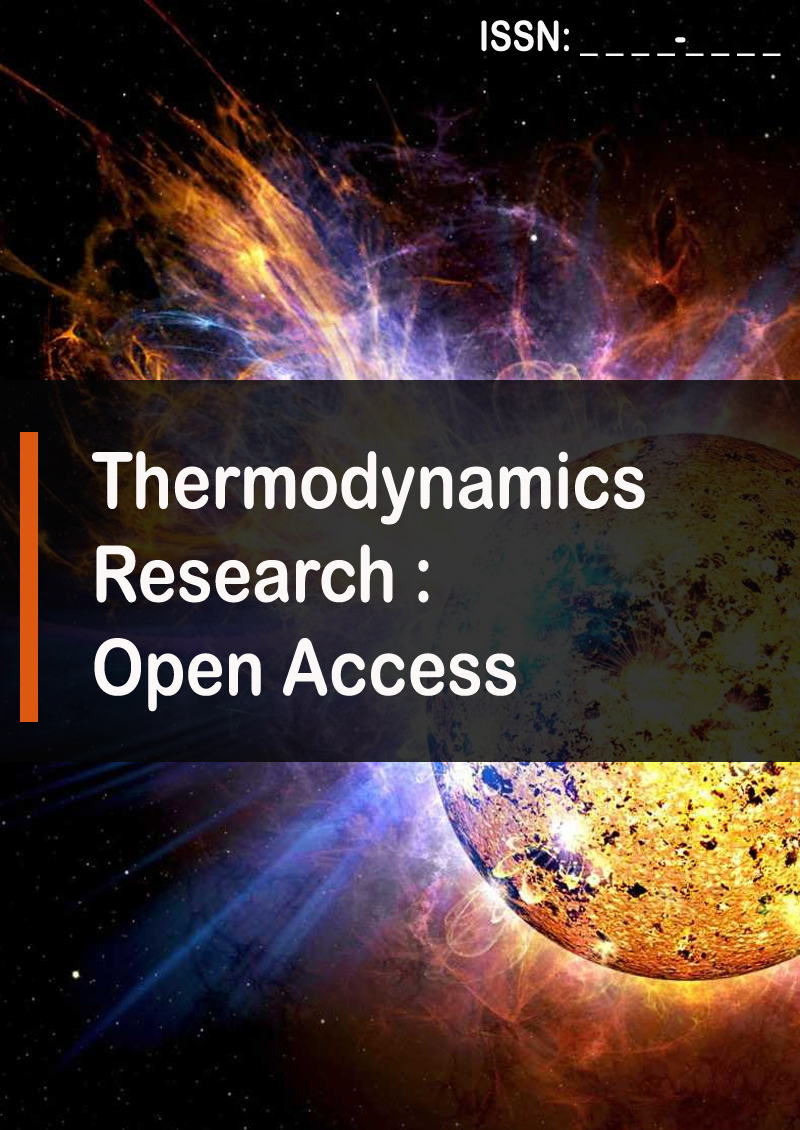Research Article - (2024) Volume 1, Issue 1
The New View at The Physics of the Planet Earth
Received Date: Jun 28, 2024 / Accepted Date: Jul 09, 2024 / Published Date: Jul 16, 2024
Copyright: ©2024 Danilov Vladimir Igorevich. This is an open-access article distributed under the terms of the Creative Commons Attribution License, which permits unrestricted use, distribution, and reproduction in any medium, provided the original author and source are credited.
Citation: Igorevich, D. V. (2024). The New View at The Physics of the Planet Earth. Ther Res: Open Access, 1(1), 01-19.
Abstract
As this article was being written, the sad news came of the passing of Seiya Uyeda on January 19, 2023 at the age of 93. Seiya Uyeda was a member of the Japanese Academy of Sciences, a professor at Tokyo and Tokai Universities, a foreign member of the academies of sciences of various countries, including the Russian Academy of Sciences. His scientific interests included the magnetism of rocks, heat flows on oceans and land, plate tectonics, dynamics of subduction zones, etc.
Introduction
This article is written under the impression of reading Seiya Uyeda's (ä¸?ç?°èª ä¹?) book "The New View of the Earth. Moving Continents and Moving Oceans". A wonderful book where, in simple Japanese, ordinary words, without cluttering the text with elaborate expressions and a multitude of mathematical formulas, without introducing unclear, rather unrealistic, assumptions, the author spoke about the process of understanding the structure of our planet. He approached the material being considered very critically, indicating not only accepted facts, but also contradictions. He argued the unsoundness of some hypotheses, but in others, he did not notice any obvious distortions of reality.
Although the result of the research conducted by him was an increase in the number of questions rather than found answers, this work determined the main circle of issues that should be given attention to understand the physics of processes occurring on the planet. As they say, "Correctly posed questions are already half the way to a solution». The goal of this article will not only be to answer the questions raised in the book, but also to add others, explain them, and also bring them together into a single mechanism that controls the majority of processes happening on the planet and that can be applied to any Earth-like planet.
Like in the book of Uyeda, the article will not contain formulas or unverified numbers. All evidence is presented in the form of measurement results that visually show the behavior of the parameters being considered, and in the form of graphs. Also, natural phenomena that can be observed should and can serve as evidence. They can be considered as the results of experiments set by nature. The combination of these phenomena provides a basis for the assertion of the validity of the proposed approach to the physics of the planet.
Since the book is quite large in volume and there is no possibility, or need, to transfer all of the interesting information in it, we will only quote the specific tasks or puzzles in it that require an answer. The main natural phenomena, according to Uyeda and his predecessors, that are subject to consideration and resolution are: "Some Unsolved Problems in Geophysics" written by JI. G. Adams, President of the American Geophysical Union, in 1947, and in it, the following six problems were listed:
• origin of mountain systems;
• origin of geosynclines (deep basins filled with deposits);
• causes of volcanic eruptions and other magmatic processes;
• causes of deep-focus earthquakes;
• origin of Earth's magnetic field;
• temperatures prevailing in the Earth's depths. \
Although the listed problems were not the only pressing issues, they were indeed of great importance. Furthermore, none of them has been fully resolved to this day; all of them remain as pressing as ever. “Page 9, Uyeda [1].
Following is the question of mobilism, that is, the movement of continents- what and how does it drive them to move? The hypothesis of movement from the process of cooling of the internal mass is shown to be insufficient. This ends the list of questions in the book.
Allow Me to Add More to This List
• How is the mass distributed inside the planet?
• How is the high temperature inside the planet maintained? (almost a repetition of the 6th question from the book)
• The shape of the Earth geoid- why? Accepted but not real.
• What forces drive the movement of ocean waters, creating the main ocean currents?
• How to explain the behavior of water tides in the ocean?
• What forces drive the air masses reaching stratosphere heights?
• "Killer waves"- the reason for their appearance?
Since the laws of physics apply to other planets as well, it's probably appropriate to add another question to these issues- the behavior of the Moon. Why does it and many other planet's moons rotate around their axis as they orbit their planet? Although these questions appear to be from different fields of knowledge and involve different phenomena and even planets, as will be shown below, they are united by one force, or rather, its manifestation. This is the external force of gravity acting on the internal mass of the planet, leading to the phenomena mentioned above. Of course, not all problems explained by the proposed mechanism of planetary interaction are addressed. Some can be seen in the article, where more data from measurements and observed facts are presented [18].
Let's consider the principle of nature study set by Newton: "I do not invent hypotheses. Everything that cannot be deduced from phenomena should be called a hypothesis; but metaphysical, physical, mechanical, and hidden properties have no place in experimental philosophy». All the laws he derived are real and still work today. He also said, «…Either don't report anything new or have to spend all your energy defending your discovery». We will answer all the questions asked, though it may not be in order. The f irst and main one will be the distribution and movement of matter inside the planet. All the others will be additional confirmations of the first, as they are manifestations of it. Additionally, I would like to mention the excellent book by O.N. Korotsev, "Astronomy," which gave a lot of insight into what is happening on the planets.
Accepted but Not Real
It is necessary to immediately say about those postulates that are now accepted by some, but in reality have no place to be:
* "Coriolis force" - this force does not actually exist. It is a hypothetical "force" introduced to describe the behavior of a body when transitioning from different observation systems. There is no source of this force in nature. It does not move or act on anything.
* Satellites do not fall or miss their planets. They move in orbits where the centripetal forces are equal to the gravitational (attractive) forces. There is no free fall with acceleration, and therefore tidal effects can be observed.
* Convection inside a planet. Convection cannot exist within a planet's body. Often, the example of a heating teapot is used to describe convection, but a planet is not a teapot, it is more like a thermos. And in a thermos there can be no convection- once the temperature is distributed, it will not change this distribution if there are no external influences. Of course, this is without taking into account minor, insignificant lo: If the planet is not heated by the Sun, then the temperature on the surface will drop to minus, which means that internal heating of the planet is very small.
In Uyeda's book, the question of convection is given a lot of space- from pages 171 to 190. Many options are considered, even up to convection in the mantle!!! The result was such a statement: "There is no need to say that the problem has not been finally solved by us. A whole series of scientists continues to work on it and at present time».
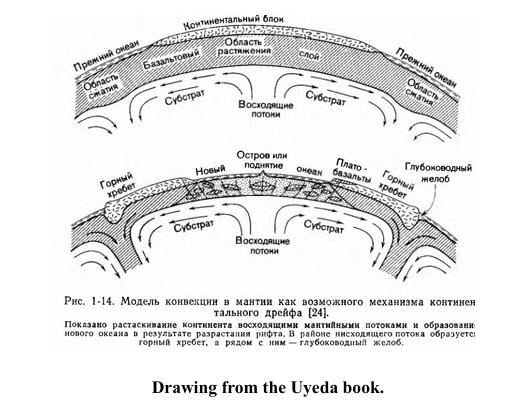
Such drawings do not reflect reality - rising streams will not cool down without cooling. The ocean does not boil, does not receive heat, and the temperature difference on the surface of the planet and under the crust exceeds 3000 degrees Celsius. There is no active heat transfer. A thermos, in fact a very good one, has been working for many centuries.
These streams explain the generation of the planet's magnetic f ield, these streams explain tectonic movements and much more. Taking the hypothesis of convection as a working one and building theories on this basis, scientists are far from reality, replacing them with fantasies. Reality, at least on the example of a kettle, says that the kettle, in the end, boils and there is no convection in it, there is a fierce mixing with one temperature throughout the volume. For reference, the boiling temperature of iron and silicon is only 2800 degrees Celsius.
Additionally, it is worth noting that convection requires a constant inflow of energy. It follows that there must be a perpetual, inexhaustible source of heat inside! The reality observed on the planet does not provide examples of this. Based on what has been said, it must be considered that everything underlying this hypothesis is definitely false (see Newton's law):
• It is doubtful to consider nuclear reaction (radiogenic hypothesis) as a source of maintaining high temperature inside the planet for the following reasons: the lava flowing from volcanoes is less radioactive compared to, for example, the radiation from an atomic power plant reactor. Also, the concentration of radioactive elements is very low in the overall mass of the planet. Most of them have a short half-life.
• The inflow of water into the ocean does not correspond, or even contradicts, the inflow (bulge) of the Earth's crust
Distribution of Mass Within A Planets Body
Based on the previously mentioned Newton's principle, let's see what "phenomenon" can be taken as a prototype of the planet. A very suitable for this is the well-known spherical aquarium. It is f illed with water and various materials with different specific weight - sand, stones, plastic toys, fish, feed, etc. As they are distributed, everyone knows. If you tilt it, a shift will occur, and if you rotate it, a constant movement directed towards the Earth by the heavy mass will occur. The aquarium is in a constant gravitational field of the Earth, similarly the Earth is in the attraction field of the Sun. And the Earth is such an aquarium relative to it. And the distribution will be similar - closer to the Sun, heavy masses, the lightest on the opposite side. Now if we imagine that the walls of the aquarium are made of soft, rubber-like material, we can simulate the behaviour of the Earth's crust under the action of the attraction forces of the Sun. If we add water to an inflated air balloon, we will get a visual representation of the behaviour of the Earth's crust - "hump" and its movement upon rotating the balloon.
It should be noted that the planet is in a nearly equipotential field of the Sun, meaning that any part of it is attracted to it equally. The distance to the Sun is immeasurably larger than any distance on the planet. The only significant difference between these two vessels is that the weak gravitational forces of the mass located inside the aquarium do not affect its distribution, or rather do not show themselves, while large masses of the planet can redistribute it.
Inside the planet, if considered separately from external forces, the total gravitational attraction vector at any point is directed towards the center, and the value of the force decreases to zero at the center where the bi-directional attraction from the peripheral masses is compensated. If external gravitational forces are absent, the heavy components of the planet's matter will strive to sink into the central region, driving the lighter ones closer to the surface.
Therefore, the regions where denser masses can accumulate are located in the center of the planet and closest to the external source of gravity and the inner side of the crust. Since the main external sources are two - the Sun- distant but powerful, and the Moon- much less massive but close, then there are three places of accumulation of heavy masses. Two of them are very dynamic, and the central one should be subject to oscillation and may even follow the first two. It is currently impossible to determine. Measurements based on single seismic waves cannot reflect the real picture due to the speed of events. Perhaps additional measurements of gravitational forces will be required. In our case, to describe the phenomena on the surface, it does not play a decisive role. For simplicity of description, let's assume that it moves. Let's call it the heavy part of the planet's core.
Let's consider the gravitational forces from which masses affect the readings of the gravimeter sensor. (Fig. 1.)
-Fз is the constant force of attraction of a planet's stationary mass.
~Fл is the variable force of attraction of the Moon.
~FÑ1 is the variable force of attraction from the mass of the core attracted by the Moon.
~FÑ2 is the variable force of attraction from the mass of the core attracted by the Sun.
~Fc is the variable force of attraction of the Sun.
At the same time, FÑ1 and FÑ2 depend on the values of Fc and Fл, as well as on the position of the Sun and the Moon relative to each other and to the Earth. In addition, the data measurements are affected by the location of the masses attracted by the Sun and the Moon, as the projections on the vertical are measured, and the same mass located directly under the sensor will show a higher value than one at the same distance but at an angle.
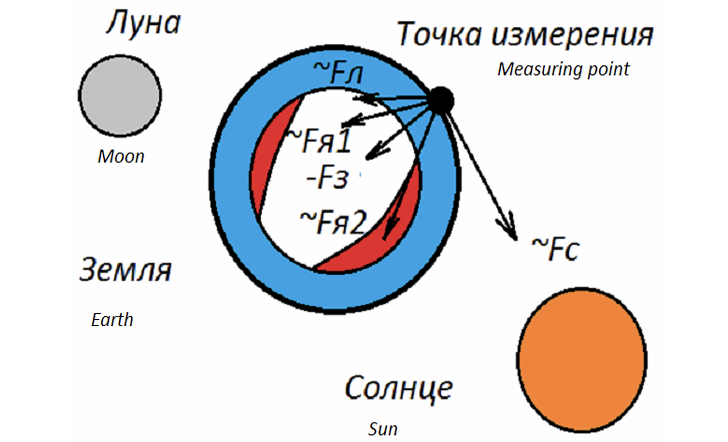
Figure 1: Schematic diagram of forces composing the readings of the gravimeter
Seasonal Shifts in The Trajectory of The Core Movement
In reality, the heavy part of the core moves from East to West and in a spiral North-South and back, with a change in the planet's position relative to the Sun (change of season). (Fig. 2)
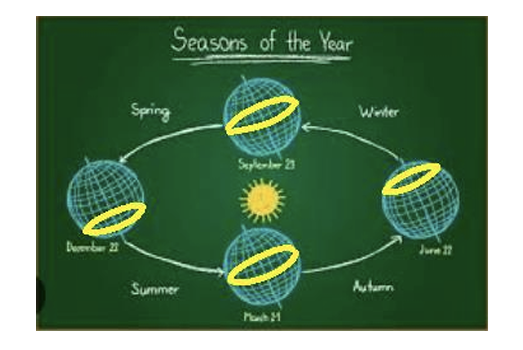
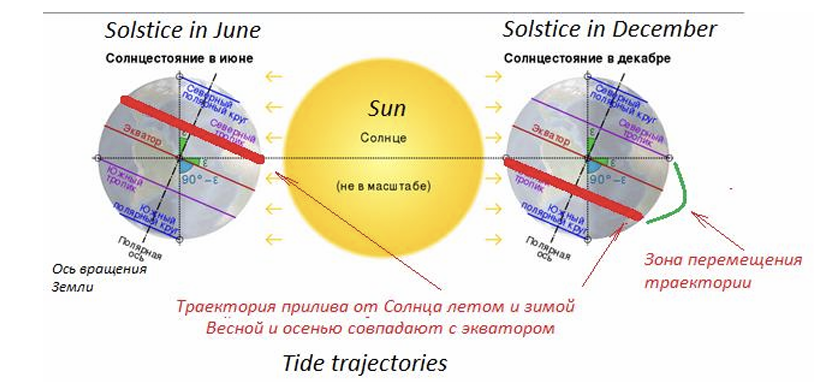
Figure 2: Seasonal changes in the trajectory of the heavy part of the nucleus
Analysis of The Results of Gravity Force Measurements
The study of the behaviour of gravitational forces, presented by employees of the DVO RAN laboratory, some of which are presented in work, and combined with their positions of the Sun ame time and tied to the station's location to the station's location, confirms the mechanism of the behaviour of the planet's internal masses previously discussed using the aquarium as an example[17].
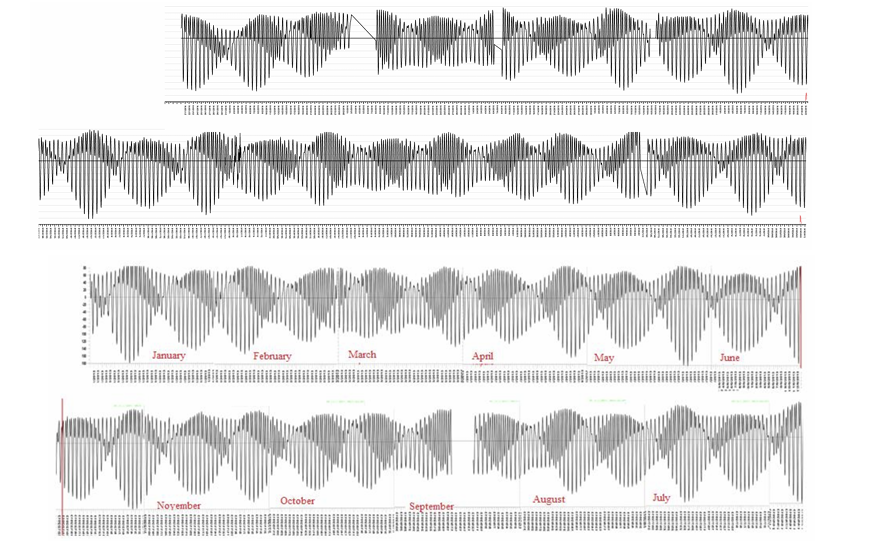
Figure 3: Gravitational force behavior before June 22nd, 2016 (upper), 2013 (lower), and its mirror reflection after. Coast area of the Sea of Japan
The changes in the trajectory of the heavy core's movement are clearly shown in the gravity charts for the year (Fig. 3). It is very well seen that there is almost a perfect match between the values before June 22nd and its mirror reflection after. This means that after the day of solar opposition, the mass inside the planet with the same daily and monthly dependence returns to the Southern Hemisphere, where, after reaching the maximum distance on December 22nd, it begins to move back. And so on, forever. Movement without end. (Fig. 2)
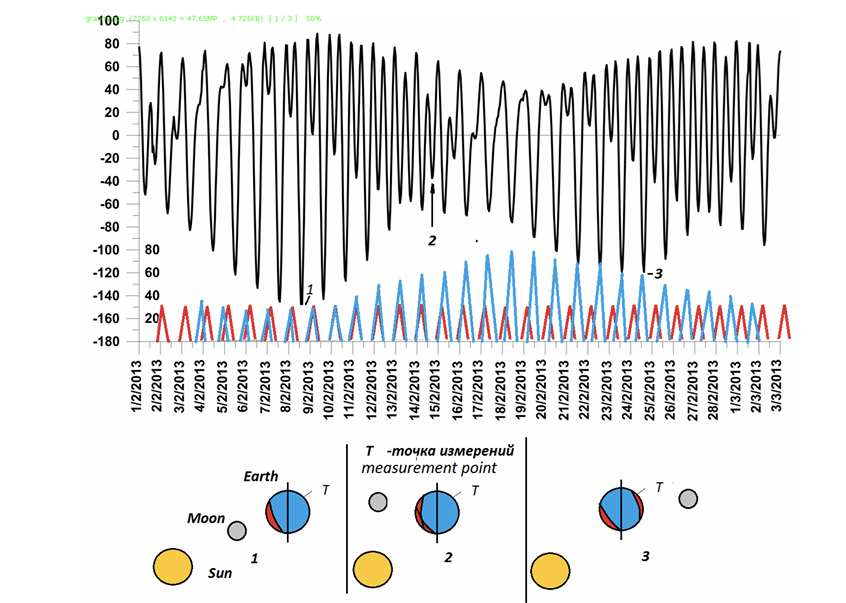
Figure 4: The graph of the forces of attraction and a hypothetical illustration of the positions of the planets for the selected minimum values that occur during nighttime. February 2013. The Sun is indicated in red and the Moon in blue- sunrise, zenith, sense
The graphs also show a decrease in amplitude in the spring and autumn months.
If we assume there is no movement of the core, then in the winter, when the Sun and Moon rise the lowest above the horizon, the change in gravitational forces should be of the lowest amplitude. But the measured values indicate otherwise. The increase in amplitude of the signal is caused by the approach and removal of the planet's internal mass.
The heavy part of the core can move away from the measurement point by a significant distance. Such a removal will necessarily lead to a change in the gravimeter readings, which is observed and very sharp, with a quadratic dependence.
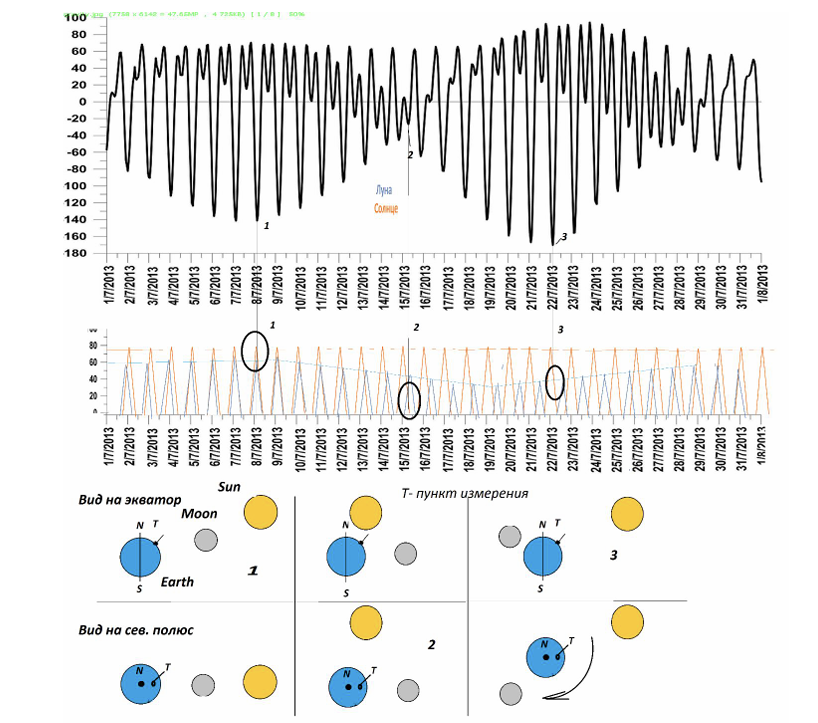
Figure 5: The graph of the forces of attraction and a hypothetical illustration of the positions of the planets for the selected minimum values that occur during daytime. July 2013. View in two projections, hypothetical
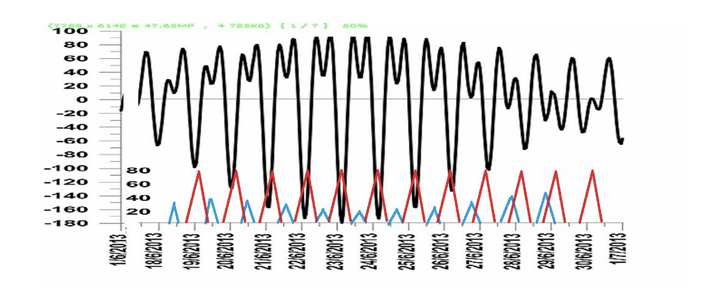
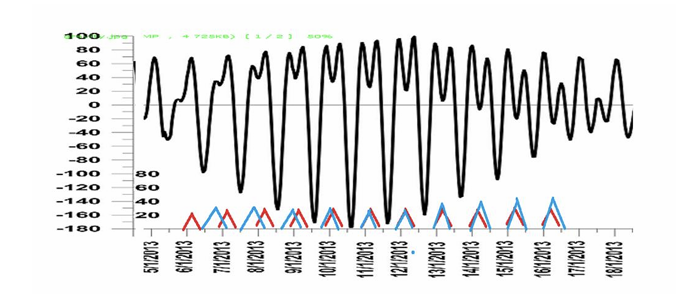
Figure 6: Almost identical shape of the signal with absolutely different positions of external forces. June and January 2013. If the minimum occurs at noon in June, then at midnight in January
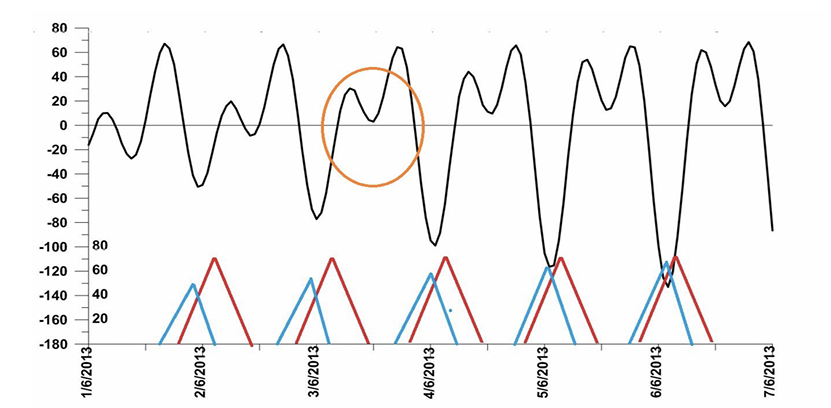
Figure 7: The behaviour of gravitational forces, June 2013. A characteristic drop during night time caused by the heavy mass core moving away from the gravimeter's location. Formation of the Dip in the Gravitational Attraction Graph at Night Time
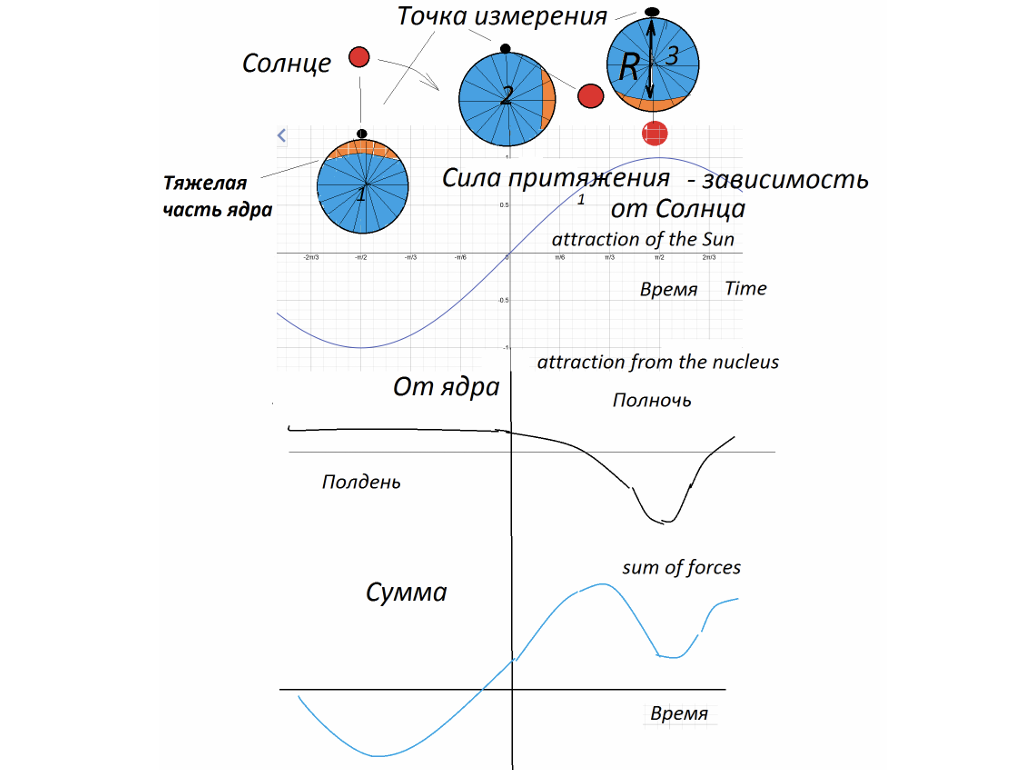
Figure 8: View from the Pole. Only the Sun's influence on the core mass is shown. Conventional illustration. Gravimeter located at measurement point
The movement of the internal mass at the initial stage has little effect on the instrument readings due to the small projection of the gravitational attraction vector onto the vertical at the point of measurement. Subsequently, the dependence becomes close to the werse square of the distance R and the value of the gravitational force decreases sharply. In the summer months, the value of R is smaller than in the winter, but in winter, the point of measurement initially further away from the core mass.

Figure 9: Distances from the measurement point to the position of the heavy part of the core in summer and winter
This displacement of the core and the collapse of the gravitational force explains the occurrence of the surface tide at night. That's why it is directly opposite the daytime tide. All that has been said about the influence of the Sun also applies to the influence of the Moon.
It is worth noting another fact - when summing up two sinusoidal signals, that is what will be from the influence of the masses of the Sun and Moon on the readings of the gravimeter, the trajectories are almost circular, a symmetrical signal shape is obtained. However, the measurement data (Figures 3-6) are clearly not symmetrical, which again confirms the infuence of additional forces.
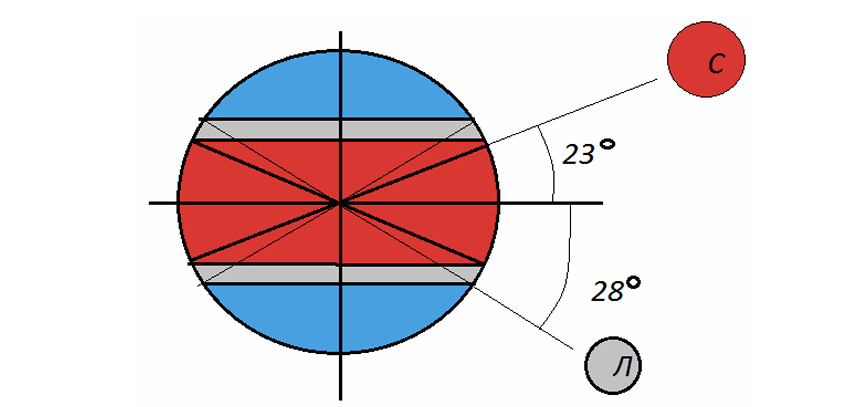
Figure 10: A schematic representation of the distribution of zones of influence from the Sun and Moon. The constant movement of mass in the same sector of the planet inevitably leads to the "bulging" of the Earth's crust, giving the planet the shape of a geoid.
Of course, one immediately wants to understand which has more impact on the formation and movement of the core, the Sun or the Moon. Unfortunately, this is not yet obvious. To understand this, a comparative analysis of the readings of gravimeters located on opposite parts of the planet is probably necessary. From existing data, it can be seen that the core can split into two parts and vice versa, causing a more significant impact on the gravimeter sensor. The difficulty of the analysis lies in the multitude of variables and their interdependence.
Conclusion
The analysis of data from gravitational force measurements leads to a clear conclusion about the influence of attraction forces from masses moving inside the planet's body on the gravimeter readings. The periodicity of these changes has daily, monthly (sidereal month), seasonal, semi-annual, and yearly (astronomical year) dependencies. The amplitude and shape of the signals also have a cyclicality and depend on both the absolute position of the Sun and Moon, and their mutual position.
In the work "Rotational Factors of Tectogenesis - History of the Question and Modern State" by L.I. Ioganson of the O.Yu. Schmidt Institute of Physics of the Earth of the Russian Academy of Sciences, a very detailed approach to the question of the movement of the planetary interior matter is systematised. Many options for explaining this movement and the evolution of understanding this issue are shown, and how many scientists have dealt with this issue is shown. By referring to this work, I try to deflect accusations of a small list of used literature. There is no need for references to what is not based, not confirmed by measurement data or natural phenomena. The words "core movement" do not yet speak of the concept of the causes that cause this movement, nor of all the consequences of this movement. And just because they are mentioned somewhere, it doesn't mean that the issue is resolved there [19].
This is the only place in the article where I will allow myself to criticise the contemporary approach to explaining the structure of the Earth. The purpose of the article is not to criticise various models, but to reveal and explain what is measured, what manifests itself in the form of natural phenomena, taking into account the laws of physics. Since many refer to the works of Avsyuk Y.N., let's take them as the generally accepted ones, although others are almost not different. For example, such a statement [9].
"The stiffness of the bond and the frequency of the free vibrations of the Earth's inner core have been estimated by several authors. The magnitude of the force acting on the inner core can be recalculated into its displacements through the value of the stiffness coefficient k. There is some uncertainty in the value of the bonding coefficient k, depending on the difference in density values between the core σ1 and the surrounding liquid material σ2. Therefore, several variations of (σ2 - σ1) were taken into account [Avsyuk, 1996]."
Estimates show that forced internal core displacements of 0.4 11.6 m with a half-sidereal month cycle (6x10-7 sec) "stir" the surrounding liquid core with a power of 3.5-10.5x1018 erg/s. As a result, the power of the core displacement process by solar disturbances surpasses the upper limit of the power of the "generator" capable of regenerating the Earth's magnetic field. To sustain the current dipole field at 0.6 Ga, a generator with a power of 1014-1015 erg/s is necessary. For a toroidal field at 100 Ga, the "generator" must be more powerful, of the order of 1017-1018 erg/s.
The calculation that the movement of the axis (the geographic pole) is caused by the movement of the planet's core is certainly acceptable as a hypothesis, but what is the connection between the cyclicity in half a sidereal month and the movement of the Sun? Such a movement- several meters, will not be reflected in real gravimeter readings, will not create daily, monthly, seasonal, semi-annual periodicities. And there are dependencies and they are obvious- it means that it's not the core, or rather not such a movement and location. On the other hand, we all know perfectly well how unbalanced bodies affect their behavior during rotation. Just a few grams on the rim lead to the vibration of quite a massive wheel of a car. And in a planet, a relatively small accumulation of mass in some place on the inner side of the crust will lead to a change in the Chandler wobble of the axis. There is abundant data on the change in the rotation time of the planet during major earthquakes, and they occur quite far from the core.
The values of power presented by Avsyuk are not justified and do not reflect anything. It is not shown how and why the core moves, how the "generator" works (in traditional physics, there is no concept of a "magnetic field generator". It is created either by a permanent magnet or by an electric current), how the current appears and flows in it, and how the real magnetic field (MF) is created. In addition, it is said that the MF must be constantly regenerated - but why? A permanent magnet, which eventually becomes the body of the planet, does not need this. How, for example, can the Kursk magnetic anomaly be regenerated without making other regions anomalous?
As we can see, almost nothing is confirmed by neither the results of measurements, nor the known laws of physics, nor natural phenomena. This is precisely why works of this kind and similar ones are not included in the list of literature. The situation is even worse with all sorts of "mathematical models." In them, an electric current can flow in a circle, not along the path of least resistance, and magnetic "embryos" can develop and power lines can twist in eights. Physics is completely ignored. The paper tolerates everything.
Changes in the measured values of Newton's gravitational constant G at different times have led scientists to consider the influence of external gravitational forces, called gravitational waves. Many scientific organizations are actively searching for these waves and significant funds are being invested in creating installations. In the work of A.V. Vikulin, the history and problems arising in the study of these phenomena are considered in detail [14]. However, the change in the force of attraction can be explained by the internal movement of masses, especially since these changes are well recorded and appear to be periodic, depending on the position of the Sun and the Moon (Fig.3-Fig.7).
Temperature Inside A Planet, Changes in Matter Properties
What temperature and what changes in matter properties occur inside a planet - let professionals better explain this.
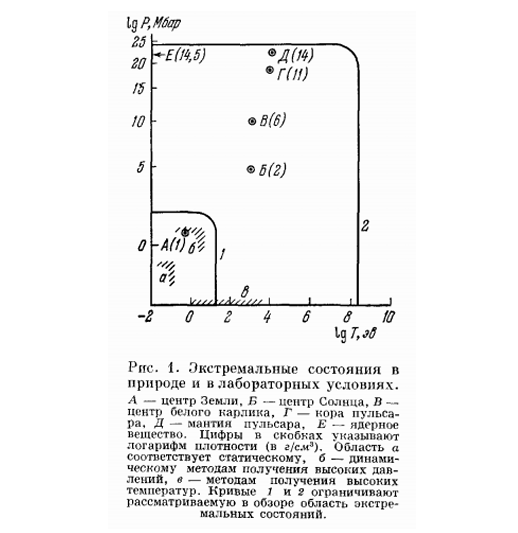
«At relatively low pressures and temperatures, the substance continues to exhibit the exceptional diversity of its forms that is inherent in its cold, uncompressed state. Accordingly, the characteristics of the substance remain highly sharp and non monotonic functions of its composition.... However, with increasing pressure or temperature, the substance acquires a more universal structure and its characteristics become increasingly smooth functions of the substance's composition. This clearly expressed trend is related to the fact that with the increase in the internal energy of the substance, it becomes possible to have a certain order and 'simplification' of its structure.
Molecules or molecular complexes break down with increasing pressure or temperature and the substance transitions to a purely atomic state. The electronic shells of the atoms rearrange, acquiring a more regular filling of energy levels. At the same time, the outer electrons, which determine the chemical individuality of the substance, are detached. Finally, if the substance remains in a solid state during compression and heating, it becomes ordered and its crystal lattice is organized. Going through a series of structural transformations, it becomes more densely packed and ultimately acquires a uniform (face-centered cubic*) structure for all substances.» You can learn more by watching the primary source [3].
This can be easily explained on a household level - squeezing a handful of cherries, we see how the cores are compressed into a fairly solid clump, and the flesh (electrons) separates. Of course, Coulomb's forces, both attraction and repulsion, have not been canceled. As already mentioned, the movement of mass occurs in a limited sector of the planet's body, determined by the angle of tilt of the axis of rotation and the direction of external forces. Fig. 10.
The movement of masses occurs at a huge linear velocity. If it is assumed that the movement takes place at the boundary of Mohorovicic, it is difficult to imagine that it is close to the speed ture, the substance acquires a more of sound in air, approximately 1300 km/h (360 m/s) (This is only an assumption!!). The movement of masses causes heating of the parts undergoing deformation and is a source of heat that maintains the planet's temperature in its current state.
There Are No Real Observations of Other Heat Sources
As previously stated, all other known energy sources on the planet have long since depleted. The maintenance of such an internal temperature is facilitated by the property of the Earth's mantle, such as low thermal conductivity. This is because with a huge temperature difference inside and outside the planet, there is a noticeable decrease in surface heating when intense solar radiation is lost.
The Appearance of An Electrical Current and The Planets Magnetic Field
Free electrons, separated as a result of heating and increased pressure, carrying a negative charge, are hundreds of times lighter than the remaining positive ions. The ions, like pebbles in an aquarium, settle on the bottom, that is, on the side facing external gravity (the Sun, the Moon), pushing out electrons. The mass inside the planet creates an electric dipole as it is separated by external gravity. The heavy, positively charged part will be closer to the surface of the Earth and to external sources of gravity (Fig. 11). Of course, the Coulomb forces which work on attraction at the point of contact and repulsion within the resulting volumes were not canceled.
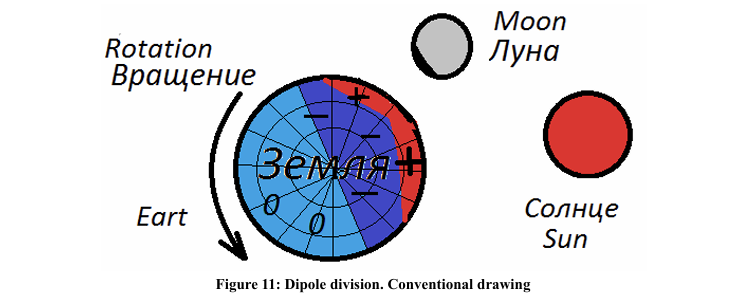
The movement of these heavy, positively charged masses occurs from East to West when the planet rotates. The movement of electrically charged parts is equivalent in effect to an electric Figure 11. Dipole division. Conventional drawing. current in a conductor. Since positively charged masses are moving, the direction of the current will also be from East to West.
According to the "compass" or "crowbar" rule - whichever one you prefer - the force lines of the magnetic field generated by such a current will be directed from the South geographical pole to the North. In other words, it's all as in reality. Figure 12.
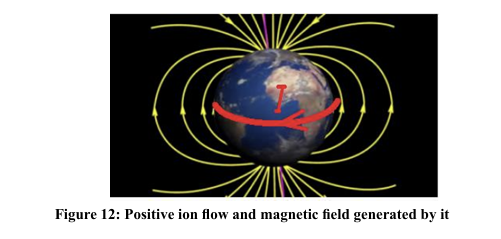
• This moving flow creates a variable (pulsating) Earth's Magnetic Field
The pulsating (at a surface point), with a period of 1 day, magnetic field is supported by the planet's paramagnetic properties, which smooth and stabilize its behavior. At the same time, the planet's body itself is magnetized.
• The magnetized planet mass creates the Earth's main Magnetic Field
It is clear that existing magnetic anomalies formed with a different direction of charged flow movement, with different speeds and potentials. The current field is not able to remagnetize them.
• Thus, the creator and driving force of charges that create the magnetic field of any planet with a liquid core are the combined forces from the Sun, moons, and neighboring planets moving relative to the planet
Very interesting measured data were presented by the employees of the Institute for Climate and Environmental Systems Monitoring in their work (Yu. P. Malyshkov, 2009) [6]. Based on the multig) Earth's Magnetic Field. year research of natural impulse electromagnetic fields on Earth (NIEFE) in seismically active regions of the Pribaikalye, they of 1 day, magnetic field is supported by the planet's (NIEFE) in seismically active regions of the Pribaikalye, they have come to the conclusion about the movement of the planet's core and related natural phenomena - seismic activity, influence on human organisms, etc. These are truly remarkable works, continuing, already at a more technological level, the research of A. Chizhevsky [5].
Intensity maps of NIEFE changes at different times exactly mimic the movement of the dipole's heavy part. From this, it becomes clear the appearance of a magnetic field on other planets where there are satellites or dynamic influence from the Sun, and its absence where there is none. This is described in more detail in [6,18]. The same applies to the 11-year cycle of solar activity that affects the Sun's core and the mass of the largest planet in the Solar System, Jupiter, and its impact on the Earth's biosphere.
The Origin of Mountain Systems
In our case, it does not matter how the planet evolved - whether it was formed from a dust accumulation or a melted debris. We take it as it is - inside the melts, on top the cooled "foam" in the form of a crust. This is what we observe. The Earth's crust is measured and classified. It is known about the unevenness of its inner surface, and it is known about the "overlapping" of its individual parts on each other. The question of where these titanic forces come from and how they act on tectonic movements remained unresolved.
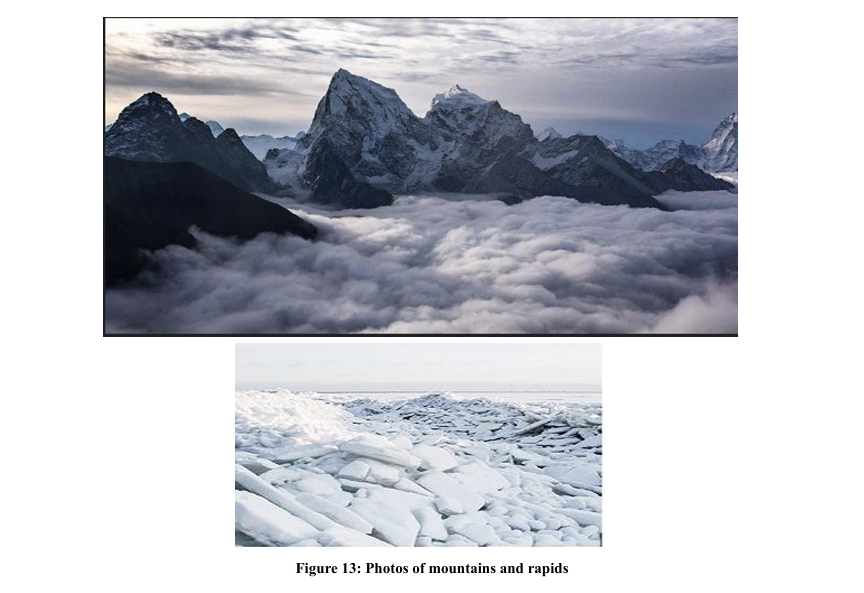
"Mountain formation is a geological process of formation of Fig. 13. Photos of mountains and rapids. mountains. mountain structures under the influence of intense upward tectonic movements, whose speed exceeds the speed of processes leading to the leveling of the Earth's surface." This process is commonly explained in this way, but, as already noted earlier, there are no upward movements inside the planet.
• First Question
The most similar phenomenon to mountain formation in the environment is river rapids. There is a flow of water in a river and there is movement of mass under the crust inside the planet. There are big masses moving in both places, there are rapids in a river and mountains on land. The location of mountains is mostly south-north, across the movement of mass inside the planet, the location of rapids is mostly across the flow, but there are exceptions in both places. The analogy is complete. (Fig. 13). The movement of the planet's core mass is constant and multi-millennial. Mountain formation alternates with the destruction and weathering of mountains.
• Second Question
The origin of geosynclines (deep valleys filled with deposits); According to Uyeda, "Many mountain rocks that make up modern mountain ranges originally accumulated on the seabed, and their thickness often exceeded 10,000 meters." If the formation of mountains is possible with the rise of the bottom of a former ocean by several kilometers, why is it not possible to form valleys at the same time? If we look at how gorges are formed, everything becomes clear.
• Third Question
The causes of volcanic eruptions and other magmatic processes; Let's go back to the rotating aquarium. The contents of the aquarium, or rather, its heaviest and densest part, move along the wall, along the boundary of the body. The same occurs inside the planet. Where is this boundary? Maybe this is the MohoroviÄiÄ? boundary? Yes, it is possible, but if we imagine the inner surface of the aquarium not from a smooth glass, but like, for example, the bottom of a mountain stream, then all kinds of deposits will appear in the form of small fragments, over which bare cliffs rise - in our case, these are the "underground" parts of mountain ranges.
Just like in ice when troughs are formed, voids and cracks occur in the Earth's core, through which magma, under the pressure of constantly moving core mass, emerges to the surface. Once a channel has formed, melting and forming a throat, it becomes a place of eruption for many centuries.
It is important to note that the pressure of the moving mass will be directed not towards the center of the planet, but towards the external gravitational force, i.e. the Sun and Moon. And moving f substance causing pressure in the area of under the throat, this mass will squeeze out magma like a piston.
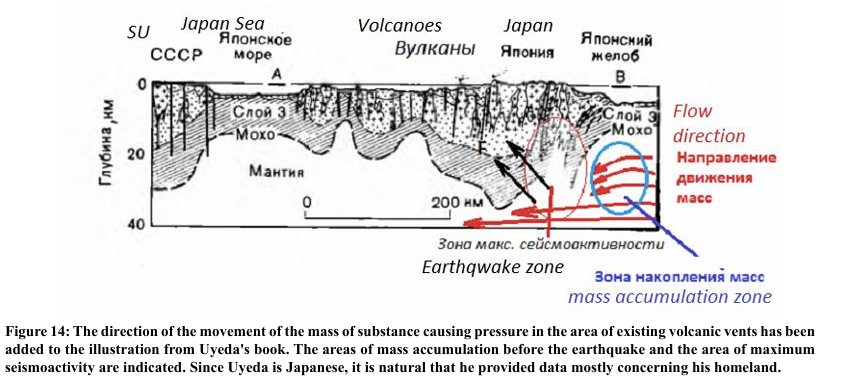
• The Fourth Question from The Book
causes of deep-focus earthquakes.
Let's consider what effects are observed during strong earthquakes:
• vibrations and movements of the Earth's crust
• witnesses report a rumbling sound, like the movement of a large mass, like a mountain landslide. The fourth question from the book: causes of deep-focus earthquakes.
• electromagnetic disturbances, magnetic storms.
• a sudden change in the period of rotation of the Earth
• the effect of "calm" of seismic activity and electromagnetic background radiation before major earthquakes is known.
Uyeda pointed out another effect: "Here it is important to mention another astonishing fact. It has long been known that every strong earthquake that occurs in Japan causes its Pacific coast to rise several meters. But between earthquakes, the coast gradually sinks."
Only the first two points are performed during weak earthquakes. It is logical to assume that these are two different types, with different physics. Since we are interested in the type of deep-focus events, we will consider its causes and consequences.
When the flow moves and after accumulating a critical mass in a convenient area, a collapse may occur which triggers an earthquake. For example, as shown in Fig. 14. During the collapse, the natural pressure will be exerted downward on the continental part. In the case of the Uyeda being considered, this is the Pacific part of the island. Afterwards, this part returns to its place.
The confirmation of such a mechanism of earthquake occurrence is that most earthquake epicenters are located on the borders of tectonic plates, that is, at geological faults. This phenomenon can be the cause of movements in the mantle's surface layers, leading to the appearance of additional earthquake epicenters and aftershocks.
It is also important to note that magnetic storms on Earth are accompanied by low-frequency oscillations of the Earth's body, and conversely, earthquakes are accompanied by electromagnetic emissions, that is, these two phenomena are interrelated, and this can also serve as confirmation, as there are spikes in electrical charge (flow of charged matter), and the transition process, as is known, has a wider spectrum than a constant current. The "calm" effect of seismic activity and electromagnetic background radiation, described in work, before major earthquakes is caused by the accumulation of a critical mass[6].
Due to the non-uniformity of the inner mantle surface, the effects on it will naturally be uneven. Powerful "collapses" of accumulated mass will cause changes in the rotation time of the planet, that is, changes in astronomical time. The collapse that occurred in the Earth's crust under the ocean and transmitted to the surface will cause a large wave, called a "killer wave."
The mass of the planet's core, subjected to the influence of various gravitational forces from the Sun and the Moon, moves along the "inner" surface of the Earth, constantly mixing, hitting irregularities, and carving a new channel for itself every day. The inner part of the Earth's crust is constantly being affected, which is transmitted to the tectonic plates, causing them to gradually move, thus moving the continents. And they indeed move in the latitudinal direction (East-West) and do not move in the longitudinal direction (South-North).
This is in response to the question posed in Uyeda's book on mobilism, as we can see it is easily explained by the proposed physics. Sometimes, in literature, movement is associated with tidal forces. But tidal forces are considered differently, these words carry a completely different physical meaning. And even if you accept their interpretation, only tidal forces cannot create movements, as they are first directed towards the East, and then exactly the same time towards the West.
Only the moving mass of the planet's core is constantly directed from East to West. The causes of the main (defining) ocean currents on the planet are the trade winds and ocean tides.
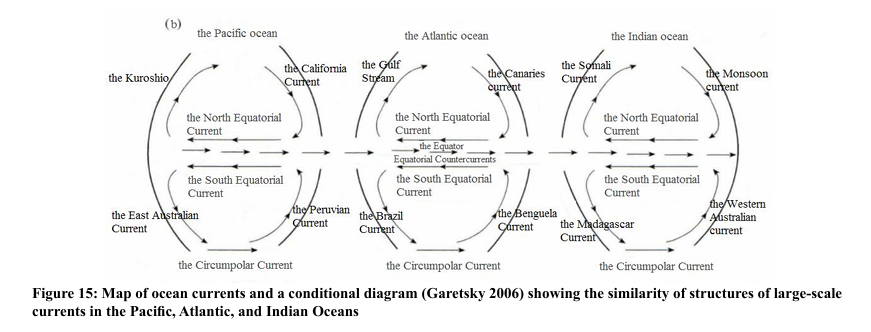
As seen from Figure 15, the main currents that create all others are the North and South Equatorial currents. If there were no continents, they would close into a circular global current. Meeting the continent, they diverge on different sides of the equator and circulate in closed ocean spaces [17].
As previously discussed, there is a movement of the core mass in the equatorial zone, and this gravitational influence on the ocean waters creates the equatorial currents. This is the only force directed constantly from East to West. These currents lead to increased ocean levels on their western parts, which in turn creates conditions for the appearance of equatorial countercurrents-surface compensating currents.
Similar gravitational effects on air masses result in the formation and maintenance of closed ring-like trade winds, whose heights reach stratospheric levels and are not impeded by land, and these winds can no longer be subject to surface heating temperature effects on Earth.
The moving "bulge" caused by the deformation of the Earth's crust due to the attraction of the heavy core part and barely noticeable to the average observer, leads to the tidal water flow in the ocean away from the location of the "bulge" to the coastal parts of the oceans, causing oceanic tides. This is why ocean tides never coincide with the passage of the Sun or Moon at the zenith in this place, but they do coincide with low tides. For the same reason, there are no significant tides in the open ocean, while according to contemporary interpretation, they should be maximum and follow the Sun and Moon.
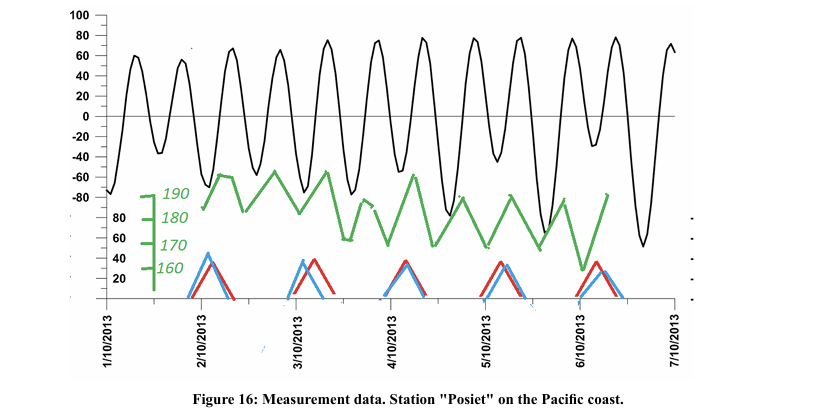
On the horizontal axis is World Time
• Black - measured gravity strength. μGal.
• Red - position of the Sun in degrees above the horizon (time of sunrise, maximum position, sunset)
• Blue - position of the Moon in degrees above the horizon (time of sunrise, maximum position, sunset)
• Green - ocean water level. cm.
A time interval has been specially selected when the Sun and Moon are on the horizon and simultaneously affecting the Earth's core.
The data on gravitational forces was provided by employees of the gravimetry laboratory of the Institute of Oceanology of the Russian Academy of Sciences.
Ocean level data is measured at the "Posiet" station meteorological station.
The times of sunrise, maximum position, sunset, and angle of ascent of the Sun and Moon were taken from the StarCalc program with a reference to the station location.
It can be seen that a couple of hours before the Sun and Moon pass through the zenith points, a tidal surge occurs and at the same time the gravitational force decreases, i.e., a tidal surge of the solid part of the planet. A tidal surge is also visible at night when there is a tidal surge of the mantle as the planet's core moves to the opposite part of the Earth.
The “hump” on the mantle will change its position and size daily depending on:
• season (tilt of the rotation axis);
• distance of the Moon and Sun from Earth;
• "phase", i.e. different positions of the Moon and Sun; and the tidal surge near the shore will not be constant, but will depend on these factors and the bottom topography.
Now about the tidal rise (surge) on the opposite side of the Earth's sphere. Unfortunately, this is difficult to demonstrate visually, as in the first case, but here too everything is quite simple. The shifted towards the Sun and Moon mass of the planet's core will weaken the gravitational force on the opposite side of the ball proportional to the square of the shift distance. On the graph provided, these will be gravity forces dips (black color) during periods when there is neither the Sun nor the Moon above the measurement point. These surges of the Earth's surface also lead to an ebb at this place, and at this time, the ocean waters.
Why Do We See Only One Side of The Moon?
It is usually explained that it makes one rotation on its axis as it orbits around Earth. But what and how makes it do this?
There is another explanation, due to tidal forces, but what are the tidal forces on the Moon and how do they affect it? If there are tides, there should be ebb and flow, but they have not been detected. In principle, these two explanations are correct, but it is necessary to explain the mechanics of such movement. By the way, many moons behave similarly, rotating around their planets.
The presence of meteorite craters all over its surface, not just on the side facing space from where meteorites arrive, speaks to its former rotation. Its former rotation is also confirmed by the fact that it previously had a strong magnetic field, now only residual, i.e., what remains as magnetized particles of the lunar ground.
A magnetic field could only arise from the movement of electric charges, and movement is only possible with rotation.
During the evolution of the Solar System and the cooling of the Moon, heavier masses of interior material stopped moving and grouped on the side facing Earth of the satellite, turning the Moon into a kind of "see-saw" and causing it to rotate towards us with the same heavy side. And just like the see-saw, it swings, relative to the heavy part, creating what is known as libration, allowing the Earth observer to glimpse behind the geometric edges of the visible flat circle. Fig. 17. It seems that the same fate awaits Earth in the future.
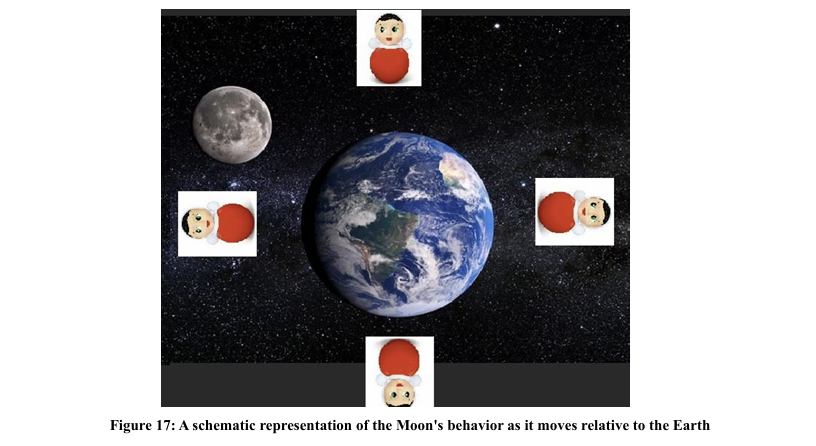
Thus, the Earth's gravitational force not only holds the Moon in its orbit as a satellite, but also causes it to constantly rotate, which consumes energy and may lead to partial cooling of the Earth. On the other hand, the mass of the Moon affects the movement of the Earth's inner core, and the movement of the core leads, due to frictional forces, to the warming of the planet.
The fact that most satellites rotate around their planets, facing them with one side, and the rotation of planets such as Venus and Mercury is synchronized with the movement of the Earth (these two planets face the Earth with one hemisphere when they approach it), indicates that planets interact with each other as bodies with offset centers of mass. In this case, with a liquid, mobile core, this center of mass can move within the solid envelope of the planet.
Conclusion
For those who have read to this point, you probably noticed that there is nothing particularly difficult about what has been said. You don't have to be a big expert in the hypotheses and models written in "scientific" books on these topics to understand the essence of the discussed issues. Just a high school level and knowledge of basic physics laws is enough. This is what made Sayed Wady's book appealing, and this is such an approach to research.
The consideration of mathematical models not based on measured data, not on the basis of observed effects, not on real facts, not on known and proven physics laws, and sometimes even contrary to them, cannot lead to any positive results. And sometimes there is not enough data to create more or less realistic models.
The explanation of many natural phenomena by one real, observable, and measurable cause allows to reduce the number of options (hypotheses) arising around the phenomena under consideration. One cause can be studied more thoroughly based on the multi-faceted manifestation of it. A structured Science of Earth emerges, where such sciences as oceanology, geophysics, magnetic field physics, geology, atmospheric physics and similar, are included as branches of the general one. The Science of Earth itself acts as a component part of the Science of the World, in which Earth is considered as one of the objects of research, and many processes related to it and studied, can be transferred to other planets [19].
References
1. Uyeda S. New View of the Earth / Translation from English by B.A. Borisov. - Moscow: Mir, 1980. - 214 p.
2. O.N. Korotcev. Astronomy. - St. Petersburg: Azbuka-Classika.2003. - 736 p. ISBN 5-352-00496-8.
3. Dr. Gnedin. Yu.N. Reviewers: Dr. Batrakov Yu.V., Cand. Sc. Vitinskiy Yu.I., Dr. Medvedev Yu.D., Cand. Sc. Naumov V.A., Cand. Sc. Popov V.S., Cand. Sc. Sokolov V.G., Cand. Sc. Tolbin S.V. D.A. Kirzhits "Extreme States of Matter (Superhigh Pressures and Temperatures)". Progress in Physical Sciences, Physics of Our Days. Volume 104, 489 508 (1971).
4. Iosilevskiy, I. L. (2010). Polarization of a plasma in massive astrophysical objects. High Temperature, 48(6), 766-771.
5. Chizhevsky, A. L. (1976). Earth echo of solar storms. Moscow: Thought Publ., 367 p.
6. Malyshkov, Y. P., & Malyshkov, S. Y. (2009). Periodicity of geophysical fields and seismicity: possible links with core motion. Russian Geology and Geophysics, 50(2), 115-130.
7. Proshkina, M.G. Valitov, R.G. Kulinic, T.N. Kolpashchikova STUDY OF TIDAL VARIATIONS OF GRAVITY FORCE IN THE TRANSITION ZONE FROM THE CONTINENT TO THE JAPANESE SEA
8. G.p. Arnautov, e.n. Kalish, yu.f. Stus, m.g. Smirnov, i.a. Bunin, d.a. Nosov institute of automation and electrometry of the russian academy of sciences, novosibirsk measurement of gravity force variations during solar eclipses on july 31, 1981 and august 1, 2008 according to the results of gravimetric observations in the novosibirsk region yavsyuk y.n., adushkin v.v.
9. Avsyuk Y.N., Adushkin V.V, Ovchinnikov V.M. Comprehensive Study of the Mobility of Earth's Inner Core // Physics of the Earth, 2001, No. 8, pp. 64-75.
10. Ovchinnikov V.M. Comprehensive Study of the Mobility of Earth's Inner Core // Physics of the Earth, 2001, No. 8, pp. 64-75.
11. Sidorenkov N.S. Physics of Rotational Instabilities of the Earth. M.,science. Fizmatlit, 2002, 384 pages.
12. Kiselev, V.M. Rotation of the Earth from Ancient Times to the Present: Monograph / V.M. Kiselev. - Krasnoyarsk: Siberian Federal University, 2015. - 262 pages. ISBN 978-5-7638 3199-3.
13. Melchior P. Earth Tides. "MIr" Publishing Moscow, 1968.
14. Vikulin, A. V. On the Geodynamic Detector of Gravitational Waves / A.V. Vikulin // Space and Time. 2014 No. 1(15). - pp. 196-207. Stationary network address: 2226-7271provr_st1 15.2014.71
15. Dehant V. Tidal Parameters for Earth // Ph. Earth and Pl. Int. –1993. – vol. 76. – pp. 259-315.
16. Shtokman V.B. "Equatorial Countercurrents in Oceans", Leningrad 1948.
17. Garetsky R.G. Dobroliubov A.I. "Tidal Discrete-Wave Movements and Drift of Continents". Geotectonics 2006, No.1, pp. 3-13.
18. Danilov V.I. "Vestnik of Perm University. Geology" 2022, Vol. 21, No. 3.
19. Ioganson L.I. "Rotation Factors of Tectogenesis - the History of the Question and the Current State". In the book: "Rotation Processes in Geology and Physics". Ed. E.E. Milanovsky. M. Komkniga, 2007. Pp. 505-522.


